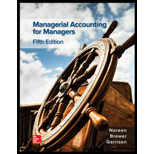
Concept explainers
1.
Introduction: The difference in costs between the variable alternative is used to calculate financial advantage and disadvantage.
To calculate: The reference value that M should consider while pricing IC-75
2.
Introduction: The difference in costs between the variable alternative is used to calculate financial advantage and disadvantage.
To compute: The difference value offered by IC-75 relative the competitor’s offering for 4000 hour of usage.
3.
Introduction: The difference in costs between the variable alternative is used to calculate financial advantage and disadvantage.
To compute: the economic value of IC-75 after 4000 hour life.
4.
Introduction: The difference in costs between the variable alternative is used to calculate financial advantage and disadvantage.
To compute: The possible price M should consider while setting price for IC-75
Want to see the full answer?
Check out a sample textbook solution
Chapter 6A Solutions
MANAGERIAL ACCOUNTING F/..(LL)-W/ACCESS
- You have been asked to test the effectiveness of Ingo Corporation’s control of manually approving all purchases over $25,000. During the year, Ingo Corporation has made 1,000,000 purchases, of which 3,000 were over $25,000. Jian Zhang, CPA, your supervisor, asked you to use a tolerable deviation rate of 4 percent (although she expects the rate to be only approximately 0.50 percent) and a 5 percent risk of assessing control risk too low. Use the following to determine the planned assessed level of control risk and the assessed level of control risk. (Planned) Assessed Level of Control Risk Tolerable Deviation Rate Low 2−7% Moderate 6−12% Slightly below the maximum 11−20% Maximum Over 20% b. Determine the appropriate sample size and allowable number of deviations using Figure 9.4. sample size:arrow_forwardWhat is cm ration? General accountingarrow_forwardPlease help me solve this financial accounting problem with the correct financial process.arrow_forward
- You have been asked to test the effectiveness of Ingo Corporation’s control of manually approving all purchases over $25,000. During the year, Ingo Corporation has made 1,000,000 purchases, of which 3,000 were over $25,000. Jian Zhang, CPA, your supervisor, asked you to use a tolerable deviation rate of 4 percent (although she expects the rate to be only approximately 0.50 percent) and a 5 percent risk of assessing control risk too low. Use the following to determine the planned assessed level of control risk and the assessed level of control risk. (Planned) Assessed Level of Control Risk Tolerable Deviation Rate Low 2−7% Moderate 6−12% Slightly below the maximum 11−20% Maximum Over 20% Expected Population Deviation Rate (as Percentages) Tolerable Deviation Rate 2% 3% 4% 5% 6% 7% 8% 9% 10% 15% 20% 0.00% 149(0) 99(0) 74(0) 59(0) 49(0) 42(0) 36(0) 32(0) 29(0) 19(0) 14(0) 0.25 236(1) 157(1) 117(1) 93(1) 78(1) 66(1) 58(1) 51(1) 46(1) 30(1) 22(1) 0.50 * 157(1)…arrow_forwardWhat is taxable income? Financial accountingarrow_forwardI need the correct answer to this financial accounting problem using the standard accounting approach.arrow_forward
- On September 1, Rivertown Inc. paid $9,000 for a six- month insurance policy that begins on September 1. What amount would appear in the Prepaid Insurance account on an adjusted trial balance dated December 31? A. $3,000 B. $1,500 C. $4,500 D. $0arrow_forwardPlease provide the accurate answer to this general accounting problem using appropriate methods.arrow_forwardsolve this question step by step and correct approach.arrow_forward
 Excel Applications for Accounting PrinciplesAccountingISBN:9781111581565Author:Gaylord N. SmithPublisher:Cengage Learning
Excel Applications for Accounting PrinciplesAccountingISBN:9781111581565Author:Gaylord N. SmithPublisher:Cengage Learning
